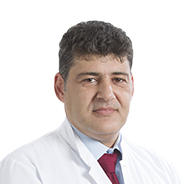- HYGEIA
- Vision & Mission
- Timeline
- Organizational structure
- Press Releases
- Social responsibility
- Awards and Distinctions
- Human Resources
- Scientific & Training activities
- Articles – Publications
- Our Facilities
- Magazines
- Healthcare Programs
- Doctors
- Services
- Medical Divisions & Services
- Imaging Divisions
- Departments
- Units
- Centers of Excellence
- Emergency – Outpatient
- Nursing Service
- Ambulances
- Patients
- Hygeia
- Υπηρεσίες
- Ιατρικά Τμήματα & Υπηρεσίες
Breast Center
Hygeia Breast Unit specializes in early diagnosis and therapy of breast disease.
Breast cancer poses a huge impact on woman’s health worldwide. In the female population it comprises the most frequent type of cancer and the second most common cause of death from malignancy, second only to lung cancer. In men it is 100 times less frequent than in women and constitutes approximately less than 1% of malignancies. In our unit, we offer a comprehensive approach regarding prevention, early diagnosis, as well as individualized treatment.
Prompt diagnosis of breast disease, tailored therapy and regular patient follow-up constitute the cornerstone of our work in the Breast Unit. We put patient care first, with medical consultation and patient support in all stages of disease, from diagnosis, through surgery, up to adjuvant therapy and follow-up.
Highest quality medical care with the latest state-of-the-art diagnostic and therapeutic modalities is being provided. Patients are being taken care of by a team of highly expert professionals who specialize exclusively in breast disease.
Since its foundation in 2004 the Breast Unit, enjoys constant development. Multidisciplinary team approach amongst our trained staff from all specialties dedicated in the different fields of breast disease management ensue the best outcome for our patients.
Current medical literature demonstrates that breast cancer comprises a heterogeneous group of diseases, dictating that each woman with breast cancer should be treated individually. The secret of our successful management of patient care lies in the doctrine of tailored breast cancer treatment.
Breast imaging:
- Low-dose mammography (spot compression, magnification views)
- Image guided biopsies
- Specialized breast localization techniques
Our Breast Unit is in close collaboration with the following Departments/Specialties in Hygeia Hospital:
- Computed Tomography
- Breast MRI
- Breast ultrasound
- Cytopathology
- Histopathology
- Molecular Biology
- Internists, Oncologists
- Radiation oncologists
- Nuclear Medicine
- Psychology
- Plastic surgery
Diagnosis
Prevention and diagnosis
Breast cancer diagnosis: the sooner the better!
In the majority of cases breast cancer growth and development is a slow process. The time span needed for the first cancer-transformed cell to grow to a clinically palpable tumor, mounts up to several years. Tumor growth is usually painless and unremarkable.
Early diagnosis
Optimal diagnostic approach is needed in order to detect breast cancer at the initial early growth stage. It consists of a combination of:
- Clinical examination-palpation from an experienced breast surgeon.
- Mammography report from a radiologist experienced in breast imaging.
- Breast ultrasound report from a radiologist experienced in breast imaging.
- Breast MRI-whenever deemed necessary.
- Needle aspiration/biopsy-whenever deemed necessary.
Quite often the diagnosis of breast cancer might be missed when utilizing only a single diagnostic modality. It is therefore crucial that a combination of diagnostic investigations is used, since a single negative examination cannot confer complete reassurance. For instance, some breast lesions do not appear on mammography, but are visible on ultrasound and vice versa. Nevertheless, we should highlight the fact that clinical examination by a physician with high expertise on breast disease plays a pivotal role in our diagnostic approach.
During the 90’s an increase in the incidence of breast cancer with a concomitant reduction in annual breast cancer specific mortality was observed, attributed to the implementation of a mass population screening program. We can thus conclude that screening, early diagnosis and progress in systemic therapy have all markedly improved breast cancer prognosis.
Life style- Breast cancer risk factors (να είναι link)
Breast cancer is a multifactorial disease entity. In the majority of cases etiology is unknown and an identifiable underlying cause is attributed in only 30% of breast cancer cases. More than 30 different factors have been implicated as breast cancer risk factors. Not every one of them has been fully validated as a risk factor, nor their mode of action elucidated. Traditionally, breast cancer risk factors can be classified as non-modifiable (factors that can’t be altered) and modifiable (factors that depend on life style and if changed can be converted to protective ones).Already, many years of studying the marked differences in the geographic distribution of breast cancer, have resulted in a link between disease incidence and life style. An important aspect of this causal relationship is represented in the different diets, concerning not only the “quality” but the “quantity” as well. Furthermore, it is striking that not only incidence rate, but also breast cancer disease progression differs as well, depending on socio-economic, cultural and racial characteristics of patient populations.
In the western world the negative impact of obesity on breast cancer prognosis has been established. Obese patients (BMI> 25) exhibit lager tumor size at diagnosis, demonstrate more frequent lymph node disease and also display higher rates of recurrences, despite adequate treatment. This applies specifically to postmenopausal women irrespective of tumor hormone receptor expression profile. The underlying etiology is not only estrogen production from adipose tissue, but also higher levels of insulin.
Insulin is a natural hormone that lowers blood sugar levels. Type II diabetes mellitus (diabetes of the adult), or the sustained high insulin levels of a carbohydrate-rich diet increase the incidence of breast cancer and its associated mortality.
It is thus important to maintain insulin at low/normal levels and this can be accomplished with the help of a balanced diet and /or exercise. A recent U.S. study demonstrated that breast cancer patients who walk for 30 minutes show a 4-6% mortality risk reduction for the next 10 years. This risk reduction benefit equals that of chemotherapy, without its unpleasant side effects. It is also a known fact, that regular exercise improves bone health and additionally offsets fatigue and weight gain, seen with chemotherapy. A low fat diet could achieve a similar goal, yet it remains unclear whether the reduction of excess fat or caloric reduction per se, is held responsible for the decrease in recurrences observed.
It is equivocal whether these impressive results are equally important in women with normal weight. Additionally, a low-calorie diet does not seem to be of any kind of benefit to patients with normal weight. Nevertheless, the merits of regular physical exercise remain undisputed, regardless of being overweight or not.
There is evidence to suggest a link between alcohol consumption and breast cancer. Consumption of more than one “drink” a day (> 10 g of alcohol) increases the risk of breast cancer. It is probable, but yet unproven whether this impairs a negative impact on disease progression as well.
On the contrary, evidence regarding nicotine/smoking is partially controversial.
Important protective factors against breast cancer include the maintenance of a normal body weight (BMI <25), 30 minutes of fast walking a day (or its equivalent) and an appropriately balanced diet.
Surgical therapy
High percentage of breast conserving surgery, oncoplastic breast surgery
Close collaboration amongst surgeons, oncologists, radiologists and radiation oncologists is of paramount importance for ideal planning and optimal outcome of breast cancer surgery.
Our approach is individualized and tailored to meet each patient’s needs, depending on clinical examination, imaging results (mammography, ultrasound, magnetic resonance imaging, computed tomography, scanning, etc) and histology/cytology report.
A thorough and detailed consultation takes place between you and the doctor, where test results are discussed and different surgical approaches are explained. We welcome in our discussions third party participation (i.e. next of kin), if desired on your part.
In essence we distinguish two different surgical approaches:
- Breast conserving surgery (BCS), where only the tumor with an adequate rim of healthy tissue is removed. This can be accomplished either with or without the use of specialized oncoplastic breast surgery techniques.
- Removal of the whole breast (mastectomy) combined with breast reconstruction (immediate vs delayed).
Our objective is always the preservation of the breast, but without compromising oncologic safety, loco-regional control and survival. Furthermore, every patient who undergoes mastectomy must be presented with all pertinent options regarding breast reconstruction. It is imperative to stress that breast conserving surgery is unavoidably always followed by postoperative (adjuvant) radiotherapy of the remaining healthy breast tissue. On the contrary, post-mastectomy adjuvant chest wall and regional node radiotherapy may be safely omitted, but only in certain cases.
Breast can be preserved in up to 70% of cases.
If initially breast can’t be preserved, like in cases of large tumor size, or in cases of unfavorable tumor to breast volume ratio, breast conserving surgery might still be an option in certain cases, with the use of neo-adjuvant therapy. In essence neo-adjuvant therapy consists of the preoperative administration of a type of systemic therapy (chemotherapy, endocrine therapy, targeted therapy or a combination of them), in an effort to shrink (downsize) the tumor mass. At the end of therapy, its effect is re-evaluated and depending on treatment response breast conserving surgery can be undertaken.
Breast conservation is not always feasible. Depending on tumor type, location and extent, a mastectomy maybe deemed unavoidable.
Our Breast Unit covers a whole range of plastic/reconstructive operations in concert with our team of plastic surgeons in the Department of Plastic and Reconstructive surgery.
Removal of sentinel lymph nodes/axillary lymph node staging
Removal of axillary lymph nodes on the affected side (axillary lymph node staging) constitutes an integral part of breast surgery. The presence of tumor cells in the lymph nodes has an impact both on prognosis and on adjuvant treatment planning. In case axillary nodes are shown by clinical and/or bedside investigations to be positive, that is infiltrated by tumor cells, then an axillary lymph node clearance must be undertaken.
If axillary nodes are clinically negative, then the gold standard is a procedure known as “sentinel” lymph node biopsy, that is removal of “sentinel’’ node(s), the first lymph nodes that drain directly the lymph of the breast parenchyma. This comprises a form of targeted axillary lymph node sampling, to evaluate whether the axillary nodes are infiltrated by cancer cells. The procedure involves a special marking technique (sentinel lymph node mapping) that is undertaken before surgery. After removal of the sentinel lymph node(s), the specimen is sent for frozen section analysis, during the operation.
In case the sentinel lymph node(s) are found to be free of tumor cells (sentinel lymph node/s negative), then the operation ends there, sparing an axillary node clearance and its potential complications. Postoperatively, the specimen undergoes further processing and is meticulously evaluated by pathologists to corroborate findings of the intra-operative frozen section analysis. In case results remain negative, then the patient is reassured and can definitely avoid a completion axillary lymph node clearance.
Medical Team
- Director
-
 Karydas Irini
Karydas Irini - Deputy Director
-
 Konstantinou Chloe
Konstantinou Chloe - Αttending Physician
-
 Manifikos Grigorios
Manifikos Grigorios
- © 2007-2024 HYGEIA S.M.S.A.
- Personal Data Protection Policy
- COOKIES Policy
- Terms of Use
- Privacy Policy
- Credits
- Sitemap
- Made by minoanDesign
Ο ιστότοπoς μας χρησιμοποιεί cookies για να καταστήσει την περιήγηση όσο το δυνατόν πιο λειτουργική και για να συγκεντρώνει στατιστικά στοιχεία σχετικά με τη χρήση της. Αν θέλετε να λάβετε περισσότερες πληροφορίες πατήστε Περισσότερα ή για να αρνηθείτε να παράσχετε τη συγκατάθεσή σας για τα cookies, πατήστε Άρνηση. Συνεχίζοντας την περιήγηση σε αυτόν τον ιστότοπο, αποδέχεστε τα cookies μας.
Αποδοχή όλων Άρνηση όλων ΡυθμίσειςCookies ManagerΡυθμίσεις Cookies
Ο ιστότοπoς μας χρησιμοποιεί cookies για να καταστήσει την περιήγηση όσο το δυνατόν πιο λειτουργική και για να συγκεντρώνει στατιστικά στοιχεία σχετικά με τη χρήση της. Αν θέλετε να λάβετε περισσότερες πληροφορίες πατήστε Περισσότερα ή για να αρνηθείτε να παράσχετε τη συγκατάθεσή σας για τα cookies, πατήστε Άρνηση. Συνεχίζοντας την περιήγηση σε αυτόν τον ιστότοπο, αποδέχεστε τα cookies μας.









































